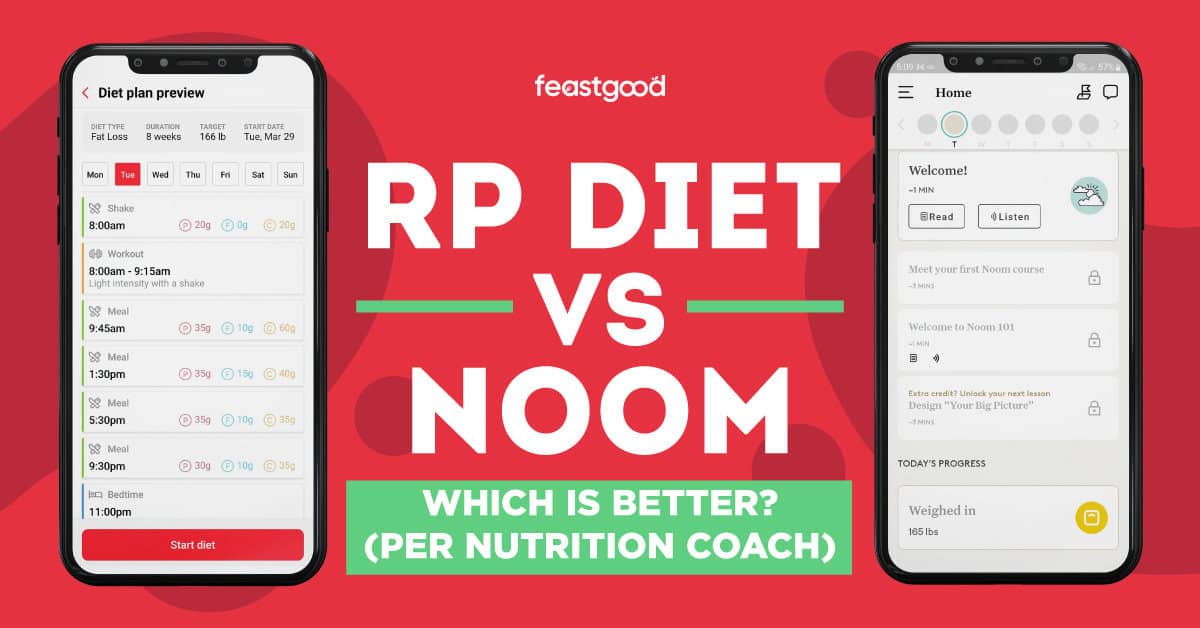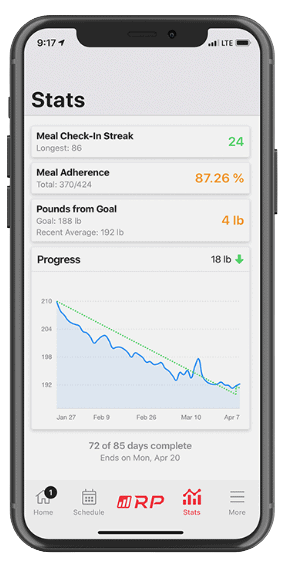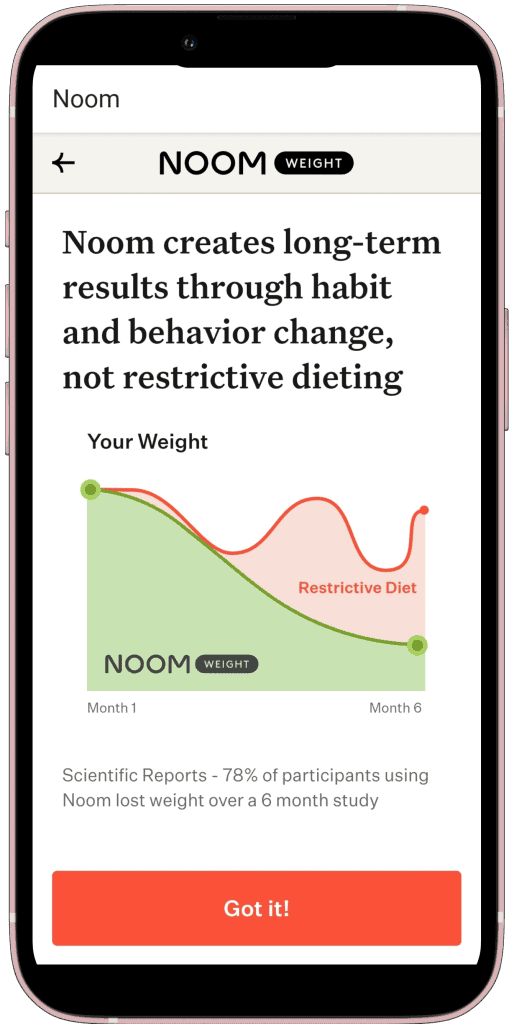Some links in this article are affiliate links, which means we earn from qualifying purchases. Learn more.
Both RP Diet and Noom are nutrition-tracking apps with an approach that goes beyond just the basics of tracking calories and macros. To help you understand which app is better, we’ve extensively reviewed and compared them in 10 key categories, including food database accuracy, level of personalization, tracking capabilities, and more.
Key Takeaways
Honest Review Guarantee from FeastGood: Our testing team purchases each product 100% independently and uses the product for several weeks up to several months before writing a review. Learn more about our review process here.
- RP Diet allows you to track macros (not calories) and focuses on nutrient timing, i.e., getting the right foods at the right time throughout the day based on your workout schedule. As such, RP Diet is ideal for athletes and people with elite performance and body composition goals.
- Noom allows you to track calories (not macros) and provides a grading system that encourages you to select more high-quality, nutrient-dense foods. The app also provides learning modules to help you change your eating habits long term. Noom is ideal for those who have the goal to lose weight.
- In our head-to-head comparison (detailed below), Noom won in 5 categories, and RP Diet won in 2. The apps were tied in the remaining 3 categories. Noom is the clear winner in this match-up. We only recommend RP Diet for very specific use cases.
Medical Disclaimer: The content of this article is provided for educational insights only. It should not be used as medical guidance. Individuals with a past of disordered eating should refrain from weight loss programs or calorie tracking. For medical advice, consult a certified healthcare professional. If you’re struggling with eating disorders, contact NEDA for assistance.

What Is RP Diet?
RP (Renaissance Periodization) Diet is a macro-tracking app focusing on nutrient timing. Meals near workouts contain higher carbs and lower fats, while meals away from workouts contain lower carbs and higher fats.
This science-backed approach optimizes workout performance by creating a rigid structure for macros per meal that users are expected to adhere to.
Users must record at each meal whether they were at, over, or under their assigned macros. The app then calculates a “diet adherence” score. This rigidity is one of the main reasons that users leave negative reviews.
RP diets approach promotes an “all or nothing” mindset that causes many users to give up if they don’t hit their macros perfectly.
On the other hand, users who are driven to fine-tune every aspect of their lifestyle to maximize athletic performance and body composition, if they do succeed in following the app’s recommendations, DO achieve their goals.
With regular weigh-ins and records of diet adherence, the app calculates whether the macro targets will stay the same, increase, or decrease the following week. This adjustment feature is a perk because the app does calculations you usually need to pay a nutrition coach for.
The level of commitment for the RP Diet approach just isn’t realistic for most people, outside of elite athletes and competitive bodybuilders, and it’s not fair for people to feel like they are failing when a much less rigid approach would get them to their goals.
Read our full RP Diet App Review.
Pros
- Weekly macronutrient adjustments based on progress
- Nutrient timing to optimize performance
- Database of foods verified by Registered Dieticians
Cons
- No calorie information
- Minimal tracking metrics (macros & weight only)
- Rigid structure
- Meal-by-meal check-ins
What Is Noom?
Noom is a weight loss app that provides live coaching and daily lessons on behavioral psychology and nutrition to help users achieve their weight loss goals by increasing their knowledge, adopting healthier habits, and improving their relationship with food.
Noom recommends a calorie range for each user and teaches them about the calorie density and quality of food with its color-coded food rating system.
Foods are categorized into green (low-calorie, nutrient-dense foods, like vegetables), yellow (moderate-calorie and nutrient-dense foods, including lean meats and low-fat dairy), and orange (high-calorie-density foods, like nuts, oils, and processed foods).
Noom teaches users that no foods are off limits, but it does encourage people to eat more foods from the green and yellow lists to meet their calorie target to assist with satiety.
One of the most significant drawbacks of Noom is that it doesn’t provide macronutrient information or targets for its foods, so people could hit their calorie target without getting the optimal amount of protein to support lean body mass.
Neglecting protein intake leads to muscle mass loss instead of fat loss, negatively impacting body composition and metabolism.
Its live coaching makes Noom stand out in the nutrition app market. A Live Chat feature in the app allows you to connect with an actual coach, who can ask you questions and provide advice and encouragement to stay on track.
This live coaching drives its higher price point, making it the most expensive nutrition app on the market today, but it’s still a fraction of the price of working 1:1 with a certified nutrition coach or Registered Dietician.
Read our full Noom Review.
Pros
- Live coaching
- Daily lessons on behavioral psychology & nutrition
- Large recipe database
- Calorie range rather than fixed calorie target
Cons
- No macronutrient tracking
- Inaccurate entries in the food database
- Higher price point
RP Diet vs. Noom: Head To Head Comparison
To highlight which app is better, I’ve compared them in the following ten key categories.
1. Food Categorization
RP Diet
Renaissance Periodization does not rank, rate, or categorize foods. It simply records their macronutrient content to tell you how much to eat at each meal to hit the suggested macronutrient breakdown for that specific meal.
Noom
Noom has a unique color coding system to classify foods based on their calorie and nutrient density using a “stoplight” system:
- Green foods, such as green leafy vegetables, have low-calorie density (a small number of calories per volume) and high micronutrient density (lots of vitamins and minerals per serving) and should be consumed in higher volumes.
- Yellow foods (e.g., whole grains and lean proteins) have moderate calorie density and should be consumed in moderation.
- Orange foods (previously known as red foods) are high-calorie and often low in micronutrients (e.g., ice cream and nuts). Because they are not satiating, these foods should be consumed in limited quantities.
The Winner: Noom
Noom’s color-coding system can help people learn what foods to prioritize at their meals to help them feel full and get the micronutrients they need to improve their health. RP Diet doesn’t care how you hit macros as long as you hit your macros.2. Tracking Capabilities
RP Diet
RP Diet has limited tracking capabilities, tracking only macros and body weight after the initial intake (which also considers daily step count, number of workouts, and workout intensity).
When tracking “single macro” foods (foods with most of their calories coming from a single macronutrient), the app ignores the small number of grams of other macronutrients that may be present in the food.
For example, a skinless chicken breast provides most of its calories from protein but also contains a few grams of fat. RP Diet would only count this toward the meal’s protein requirement.
For more examples, check out our RP Diet Food List.
Noom
Noom tracks calories, weight, exercise activities, daily step counts, and health markers like blood pressure and blood glucose. These measures give a much more well-rounded picture of your overall health.
You can also see your macronutrient consumption (carbs, fat, and protein intake) in Noom if you check each food’s nutritional info, but it’s more of a “behind the scenes” approach to macro tracking.
The Winner: Noom
Noom’s range of “inputs” (calories from food logged, exercise, and daily steps) and “output” items (body weight, blood pressure, and blood glucose) helps users to comprehend the relationship between how they eat and move their body, and how it impacts their health.3. Calorie Recommendations
RP Diet
The RP Diet’s starting macronutrient recommendations are accurate if you are honest about the frequency and intensity of your workouts and daily step count.
To ensure ongoing accuracy with macro adjustments, you must be sincere when tracking each meal, measuring your food accurately, and regularly weighing in.
If you are NOT progressing toward your goals, the suggested macronutrient changes can be aggressive. Many users have left negative feedback about how much their carbs were cut if they didn’t hit the expected rate of loss.
Noom
Noom provides a broad calorie range to help users see that they can progress without needing to be perfect each day.
That said, if users always aim for the low end of the range, they could end up severely under-eating and losing weight too quickly.
If users stay near the upper end of the range, they might not lose weight or plateau after losing only a bit, as that calorie target becomes their new maintenance level.
The Winner: Tie
RP Diet’s initial macronutrient target is more precise than Noom’s broad calorie range, which can lead to better, more predictable results. But RP Diet’s aggressive, rigid approach can make users more likely to quit before reaching their goals.In contrast, Noom’s calorie range encourages users that they don’t need perfection to see progress, dramatically improving adherence.
4. Level of Customization
RP Diet
The RP Diet allows minimal customization, but you can ignore the suggested new macronutrient targets for the week ahead. You also get to choose the number of meals you want. However, you can’t adjust the recommended macros per meal.
Noom
Noom also provides little customization. Users do not control their calorie targets and cannot change how exercise calories are treated (more on that later). However, users are free to hit their calorie target however they see fit, as there are no set macronutrient targets.
The Winner: Tie
Neither RP Diet nor Noom offers much customization. Beyond the initial intake, users do not have much influence on their calorie or macro targets.5. Coaching
RP Diet
RP Diet has no live coaching feature but built-in algorithms that adjust macronutrient targets based on regular weigh-in data compared to macronutrients consumed.
These adjustments are similar to those you’d receive when working with a coach but without any of the education, advice, support, or guidance that comes from a real person.
Noom
In the Live Chat feature, users can talk to a real human being who can provide advice, support, and encouragement and ask insightful questions to help users reflect and determine the best course of action.
The Winner: Noom
Noom earns its place as our top-rated weight loss app because of its coaching feature.6. Food Database
RP Diet
RP Diet’s database boasts over 750,000 foods, but that’s not a lot of entries compared to other nutrition apps, which have millions of entries worldwide.
However, all of the entries in the database are verified by Registered Dieticians, making it one of the most accurate databases for nutrition-tracking apps.
Noom
One of the biggest complaints about Noom is its inaccurate nutrition database. There are no “verified” entries, so it’s impossible to know what has come from a verified database and what could be subject to user error.
Although the calorie range (rather than a fixed target) accounts for some errors, it’s hard to know how much you consume if the nutritional information for the food you enter is incorrect.
The Winner: RP Diet
RP Diet has a superior food database because Registered Dieticians verify all its entries.7. Recipe Database
RP Diet
RP Diet does not have a recipe database. Users must plan meals independently to meet the target macros per meal.
That said, if you’re struggling to find recipes for the RP diet, you can check out these 10 RP Diet Recipes.
Noom
Noom has a great recipe database with over 150 options, including information about the color rating of the foods included in the recipe.
The Winner: Noom
Noom’s recipe database is a great feature that shows users how to make delicious, nutritious meals that incorporate more foods they are encouraged to eat (green foods) and fewer foods that should be limited (orange foods).8. Exercise Calories
RP Diet
RP Diet doesn’t directly add calories for exercise but increases carbohydrates on days with long and intense workouts to ensure adequate fueling. Plus, the app puts more carbs and fewer fats in the meals before and after workouts and fewer carbs and more fats away from workouts.
These changes align with our recommendation to limit fat before and after a workout so that carbs and protein digest quickly, fueling training and recovery.
This nutrient-timing strategy is good news for people looking to optimize their performance but may not help with general weight loss.
Noom
Noom’s default setting adds half of the calories burned through exercise back to the daily total. This “middle ground” approach aims to prevent people from creating too large of a deficit with exercise while still allowing for weight loss progress.
However, this feature cannot be turned off, which may cause issues for some users struggling to lose weight.
The Winner: Tie
The RP Diet approach to macronutrient ratios around workouts is ideal for someone with performance goals, but Noom’s treatment of exercise calories might work better for someone with a weight loss goal.9. Price
RP Diet
With a rate of $19.99 USD/month or $99.99 USD/year, RP Diet is on the higher end compared to other macro-focused apps like MacroFactor, Cronometer, and MyFitnessPal.
RP Diet does not have a free version (many apps do), but there is a two-week free trial (plus, get 33% off your first six months with this link).
That said, it is still significantly less expensive than Noom.
Noom
Noom is the most expensive nutrition app we’ve reviewed, but we agree with the hundreds of thousands of users who say it’s well worth the cost for the coaching service and daily lessons (see the Reviews section below).
Two months of Noom ($129 USD) is more than an entire year with any other app. The full-year membership ($209 USD) is much more economical in the long term.
One cool thing about Noom is many healthcare benefit plans are now willing to cover all or some of its cost, considering it a legitimate medical expense for weight loss assistance. If you have insurance coverage, it’s worth checking out with your benefits provider.
The Winner: RP Diet
If you don’t want to spend hundreds of dollars on a nutrition app, RP Diet delivers for a fraction of the cost of Noom.10. Reviews
RP Diet
The RP Diet Coach & Meal Planner has a 4.5 (out of 5) rating in the Apple app store, based on 9.4k reviews. That’s a minimal number of reviews, and most of the negative comments call it “rigid and inaccurate” and “not flexible enough for real life.”
Noom
Noom: Healthy Weight Loss has a 4.7 (out of 5) rating in the Apple app store, based on 799k reviews. The considerable number of reviews shows that it is a top-rated app; it is currently (as of the time of writing this article) ranked #59 for Health and Fitness Apps. The reviews are overwhelmingly positive, such as “Noom has changed my life, period.”
The Winner: Noom
Noom is our #1 rated weight loss app for many reasons, and nearly a million users agree with us.RP Diet vs. Noom: Quick Overview
| RP Diet | Noom | Our Interpretation | |
|---|---|---|---|
| Food Categorization | No food rating system. | It uses a color-coding system to classify foods as green, yellow, or orange based on their calorie and micronutrient density. | Noom helps you learn what foods to eat more of (green) and what foods to eat less of (orange) but does not provide macronutrient information; RP Diet focuses exclusively on macronutrient content. |
| Tracking Capabilities | • Macronutrients • Weight | • Calories • Exercise activity • Step count • Weight • Blood pressure • Blood glucose | Noom tracks more nutrition and exercise metrics than RP Diet and has specific health markers. |
| Calorie Recommendations & Accuracy | It does not provide a calorie target, but the macronutrient recommendations are accurate and dynamic, meaning they change based on whether you progress each week. | An extensive calorie range is provided, meaning the rate of loss could be too fast (unsustainable) or too slow. | The RP Diet App provides better recommendations and updates these recommendations as you progress toward your goal, but Noom offers a range that removes the pressure of needing to be “perfect” when hitting a calorie target. |
| Level of Customization | You can choose the number of meals per day and “save” macros from one meal for another, but you cannot change macros for each meal. | Little to no option for customization. | The RP Diet approach is relatively rigid, with a set macro ratio for each meal, but offers some customizations. Noom does not offer customization, but there is more flexibility with food choices so long as you adhere to your calorie range. |
| Coaching | No “live” coaching exists, but the app adjusts its suggested macronutrient targets based on user progress. | Live coaching is built into the app for advice, support, and encouragement. | Noom is very popular for its live coaching service (which drives its higher price point). |
| Food Database | This database has nearly 1 million entries, including chain restaurants, and all entries are verified by a registered dietician. | There are nearly 4 million entries in the database, but no records of verified vs. unverified entries, resulting in many complaints about inaccurate information. | RP diet has a superior database despite having fewer entries because the entries are more accurate. |
| Recipe Database | No recipe database. | Noom has an extensive recipe database with over 150 breakfast, lunch, dinner, and snack options. | Noom can help you figure out how to make delicious meals that emphasize “green” foods. |
| Exercise Calories | It does not track exercise calories but increases the user’s carb allotment for more intense workouts. | The default setting adds half of the calories burned through exercise back to the user’s daily calorie range, and this setting cannot be turned off. | RP’s approach is more dynamic for supporting performance but less helpful for weight loss. |
| Price | • $19.99 USD/month • $99.99 USD/year | • 2-month: $129 USD • 4-month: $169 USD • 6-month: $179 USD • 8-month: $189 USD • 12-month: $209 USD | RP Diet has a lower price point; one full year with RP costs less than two months with Noom. |
| Reviews | 4.5/5 for 9.4k reviews | 4.7/5 for ~800k reviews | Noom has significantly more reviews; even its lower ratings have positive comments about the coaching service. |
Other Comparisons With Noom
Other Comparisons With RP Diet App
About The Author

Lauren Graham is a Precision Nutrition Level 1 certified nutrition coach. She focuses on helping busy professionals balance healthy eating and purposeful movement. Lauren has a background in competitive swimming and is currently competing as a CrossFit athlete. She has a passion for training, teaching, and writing.
Why Trust Our Content

On Staff at FeastGood.com, we have Registered Dietitians, coaches with PhDs in Human Nutrition, and internationally ranked athletes who contribute to our editorial process. This includes research, writing, editing, fact-checking, and product testing/reviews. At a bare minimum, all authors must be certified nutrition coaches by either the National Academy of Sports Medicine, International Sport Sciences Association, or Precision Nutrition. Learn more about our team here.
Have a Question?
If you have any questions or feedback about what you’ve read, you can reach out to us at [email protected]. We respond to every email within 1 business day.



